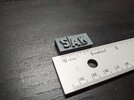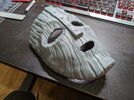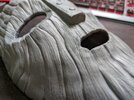On the 8K resin printer, I agree with
Astyanax . There is going to be a learning curve anyway, and it's best to go that direction. However, not all resins are smelly. Some are quite tolerable, but there are some people who can't tolerate even the slightest amount of chemical smell. There are printers out there that have filters that reduce the odour.
The location of the printer very important. Resin cures with UV light. You do not want to place a resin printer near a window. Sure, there is a see-through plastic box that covers the printer, but that is only there when printing. There are going to be times that you are taking the cover off, to add more resin or to remove the print. The print surface and the printed object is going to be covered in gooey resin that is going to drip for a while. So don't locate this next to a window, or else you're going to have issues. UV rays bounce off walls, metal and whatever, and penetrates fabric and glass, so location is important. You don't have to make the room dark, but you certainly don't want to expose the uncured resin to UV light for any appreciable amount of time. BTW, almost every kind of light produces a tiny amount of UV...most likely not specifically in the frequency of 420 nanometres.
Another thing about resin...it's messy. As mentioned previously, the print is and print surface are going to be covered in dripping resin. You're going to need to transfer that to a tub that you're going to wipe off the excess. Then you're going to pry the print off the print surface. Anything pried off is going to fly off in an unpredictable direction, so don't decorate your office with an expensive Persian rug. Also. accidents and failures happen, so you may want to get some sort of tub for the printer, in case there is a catastrophic failure of your FEP sheet. Larger printers mean larger resin tubs that hold a lot of resin.
In the long run, resin printing is higher cost because the resin costs more and inevitably you're going to break something expensive if you didn't follow a procedure of checking to make sure all of the objects you printed are stuck to the print surface. Factor in nitrile gloves and alcohol for cleaning the prints as well. If a part is stuck to the FEP and you make another print, chances are you will crack your LCD. But the benefit of resin printers is the 'almost ready' nature of the prints. In some cases, you can pop it off the print surface, clean it, cut off and file down the supports (if there were any), cure it and it will be ready for painting.
Still another location problem...temperature. Resin flows easier and cures faster when its warm, so don't think that if you put a resin printer in your garage at -40 degrees that you're not going to have problems.
TazMan2000






